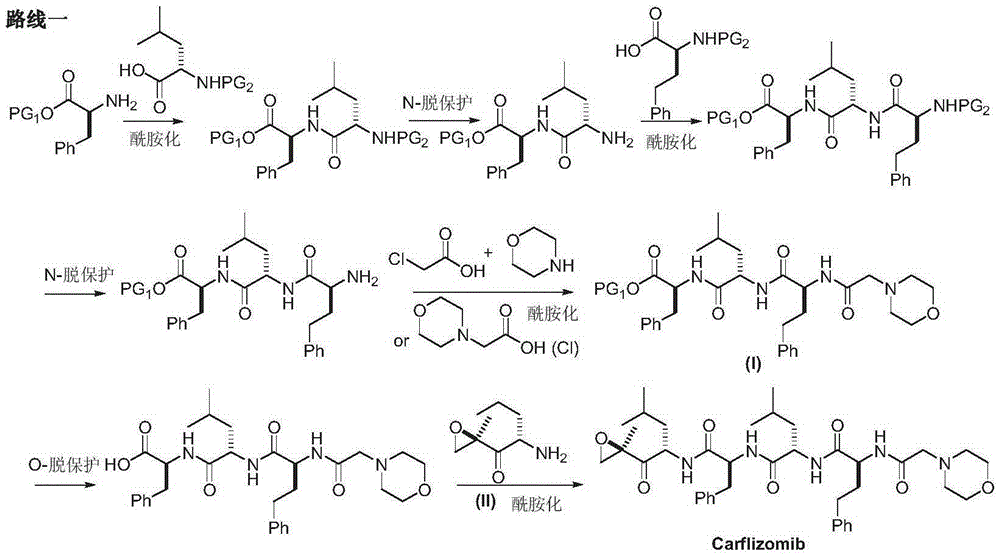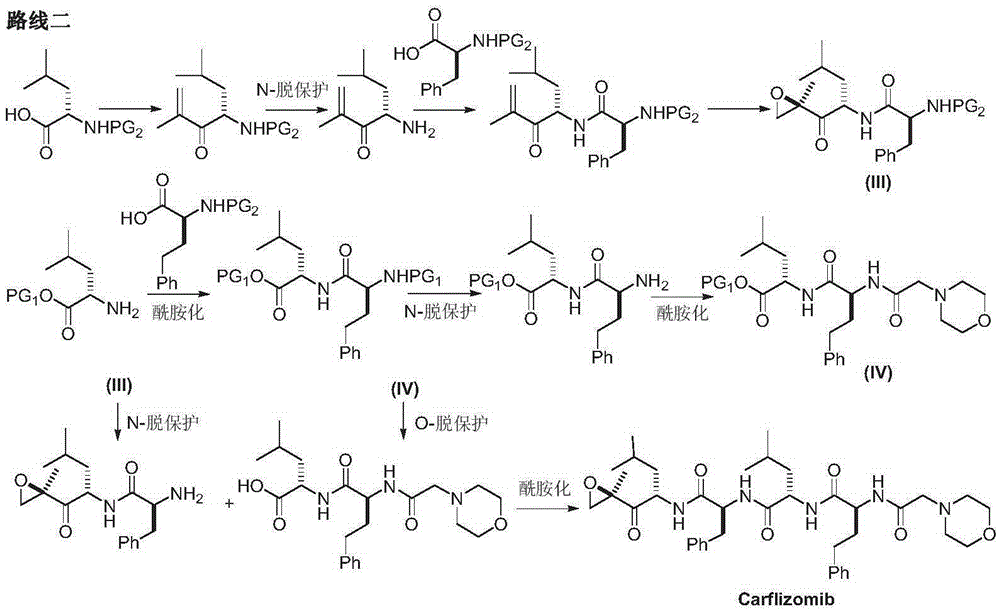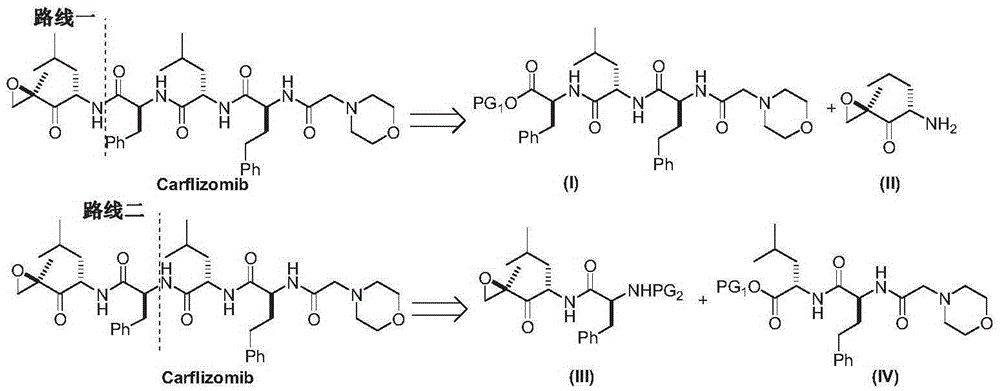The preparation method of carfilzomib intermediate
A technology for carfilzomib and intermediates, which is applied in the field of preparation of carfilzomib intermediates, can solve the problems of difficult acquisition, difficult purification, low yield, etc., to reduce the number of times of protection and deprotection, and process routes The effect of simplicity and reduction of preparation steps
- Summary
- Abstract
- Description
- Claims
- Application Information
AI Technical Summary
Problems solved by technology
Method used
Image
Examples
Embodiment 1
[0029] Add 2-(4-morpholinyl)acetic acid (V) (1.74g, 12mmol), 4-phenylbutyric acid methyl ester (VI) (1.93g, 10mmol), diisopropyl Ethylamine (DIEA) (6.43g, 50mmol) and N,N-dimethylformamide (DMF) 30mL were stirred to dissolve and cooled to 0°C. Add benzotriazol-1-yloxy tris(dimethylamino)phosphonium hexafluorophosphate (BOP) (6.7g, 15mmol), rise to room temperature after 1 hour and react for 12 hours, TLC detects that the reaction is complete . The reaction solution was poured into brine, extracted three times with ethyl acetate, the organic phases were combined, washed with water, saturated sodium bicarbonate solution and saturated brine, and dried over anhydrous magnesium sulfate. The solvent was recovered under reduced pressure to obtain 2.7 g of oily product (αS)-[2-(4-morpholinyl)acetamido]benzenebutyric acid methyl ester (VII), with a yield of 84.4%.
Embodiment 2
[0031] At 0-5°C, add (αS)-[2-(4-morpholinyl)acetamido]benzenebutyric acid methyl ester (VII) (3.2 g, 10 mmol), lithium hydroxide ( 0.24g, 10mmol), methanol 120mL and water 30mL, stirred and reacted at this temperature for 10 hours, and TLC detected that the reaction was complete. Adjust the pH to 3 with 1N hydrochloric acid, extract three times with dichloromethane, combine the organic phases, and dry over anhydrous magnesium sulfate. Dichloromethane was recovered under reduced pressure, and the residue was recrystallized from ethyl acetate and n-hexane (1 / 2) to obtain off-white solid (αS)-[2-(4-morpholinyl)acetamido]benzenebutyric acid ( VII-1) 2.65g, yield 86.6%.
Embodiment 3
[0033] Add (αS)-[2-(4-morpholinyl)acetamido]benzenebutyric acid (VII-1) (3.06g, 10mmol), L-leucine methyl ester (VIII) into the dry reaction flask (1.45g, 10mmol), diisopropylethylamine (DIEA) (6.43g, 50mmol), N-hydroxybenzotriazole (HOBt) (2.7g, 20mmol) and N,N-dimethylformamide (DMF) 30mL, stir to dissolve and cool to 0°C. Add benzotriazol-1-yloxy tris(dimethylamino)phosphonium hexafluorophosphate (BOP) (6.7g, 15mmol), rise to room temperature after 1 hour and react for 13 hours, TLC detects that the reaction is complete . The reaction solution was poured into brine, extracted three times with ethyl acetate, the organic phases were combined, washed with water, saturated sodium bicarbonate solution and saturated brine, and dried over anhydrous magnesium sulfate. The solvent was recovered under reduced pressure to obtain 3.2 g of oil (αS)-[[2-(4-morpholinyl)acetamido]phenylbutyryl]-L-leucine methyl ester (IX), with a yield of 73.9%.
PUM
 Login to View More
Login to View More Abstract
Description
Claims
Application Information
 Login to View More
Login to View More - R&D
- Intellectual Property
- Life Sciences
- Materials
- Tech Scout
- Unparalleled Data Quality
- Higher Quality Content
- 60% Fewer Hallucinations
Browse by: Latest US Patents, China's latest patents, Technical Efficacy Thesaurus, Application Domain, Technology Topic, Popular Technical Reports.
© 2025 PatSnap. All rights reserved.Legal|Privacy policy|Modern Slavery Act Transparency Statement|Sitemap|About US| Contact US: help@patsnap.com



